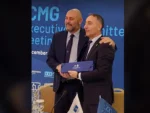In a small village on the outskirts of Moscow, where opulence meets absurdity, the Syrian dictator Bashar al-Assad and his family have found a new home. A sprawling estate, complete with Dior and Gucci boutiques, a luxury shopping mall called the “House of Dreams,” and even a Ferrari dealership, has become the refuge for Assad after fleeing his war-torn homeland. The village of Barvikha, once reserved for loyal Soviet elites, is now a sanctuary for the world’s most notorious exiled leaders.
When news broke of Assad’s flight to Russia, Ukrainian President Volodymyr Zelensky succinctly remarked: “The brave Assad has fled to Putin. But where will Putin flee?”
As Mark Galeotti highlights in his article for Spectator, Assad and his family were granted asylum in Russia on the grounds of “humanitarianism”—the same so-called humanitarianism that Assad had long denied his own people. But what exactly does Putin offer to his new guest?
In a word: luxury. Or rather, it appears to be luxury with a sinister twist. While Barvikha may look like just another wealthy village from the outside, a closer inspection reveals something far more extravagant. Behind high fences and pristine gates, the area houses not just the super-wealthy oligarchs of Russia, but also a collection of ex-dictators who have fallen from power. These include Slobodan Milošević’s family, as well as other former heads of state such as Askar Akayev of Kyrgyzstan (overthrown in the 2005 Tulip Revolution), Aslan Abashidze of Georgia’s Adjara region (who was sentenced in absentia for terrorism), and Viktor Yanukovych, the former Ukrainian president who fled the country after the 2014 Revolution of Dignity. Now, the Assads join this peculiar group of exiles.
Despite the ostentatious wealth on display, life in Barvikha is no fairy tale. It is, as Galeotti aptly puts it, a “golden cage.” The mansions here are so vast that even former Ukrainian President Viktor Yanukovych’s $52 million villa stands out as a mere drop in the ocean. Yanukovych also owns another property in southern Russia’s Rostov region. In this gilded enclave, residents are surrounded by luxury and privilege—at least on the surface. The “House of Dreams” shopping mall features high-end stores like Dior and Gucci, while a Ferrari dealership offers a playground for the super-rich.
However, the cost of residing in such splendor is steep. The Assads, like other former dictators, are not here for free. According to estimates by the U.S. State Department, the Assad family’s private wealth amounts to around $2 billion, hidden across various offshore accounts and shell companies worldwide. To maintain their lavish lifestyle in exile, they will likely spend significant sums on private security and discreet household staff, many of whom may very well be agents of Russia’s Federal Security Service (FSB). Those unable to pay their way might find themselves indebted to the Kremlin, becoming pawns in Putin’s geopolitical chess game.
Although Russia’s lavish welcome to Assad may appear generous, it also highlights the complex, even contradictory nature of Moscow’s relationship with its clients. Assad’s survival in power has always depended on Russian support, but his refusal to make meaningful compromises with opposition forces and his disregard for international norms have left him increasingly isolated. As Galeotti points out, Assad has been criticized by both Moscow and Tehran for his self-righteousness and failure to capitalize on the Russian intervention in 2015, which could have allowed him to strike a deal with rebel factions and rebuild his army. His arrogance has alienated even his primary backers.
Yet, despite these flaws, Assad remains an important asset for Russia. He may never return to Syria, and his 23-year-old son, Hafez, who was groomed to inherit the presidency, will likely never take the reins. But Assad remains a valuable tool for Putin’s regional ambitions. As Galeotti notes, Moscow is unlikely to extradite Assad to Syria or to a war crimes tribunal, as the Russian leadership continues to view him as an essential player in their wider strategic objectives.
In essence, the Assads are now fully beholden to the Kremlin. As long as they stay silent and avoid drawing attention to the atrocities committed under their regime, they may continue to enjoy their life of luxury in Barvikha. But with growing international scrutiny over Syria’s ongoing human rights abuses and the exposure of the regime’s atrocities—such as those committed at the infamous Sednaya prison—Assad’s new life in exile may not provide the refuge he expected. As his vast wealth and high-profile exile continue to attract attention, it’s increasingly clear that few will feel sympathy for the Syrian dictator, whose reign is increasingly defined by failure, oppression, and corruption.
In the end, the Assads’ luxurious exile in Russia is a reminder that for many of the world’s dictators, survival means adapting to new power structures. And in Putin’s Russia, even exiled tyrants can find shelter—so long as they remain useful to the regime.







